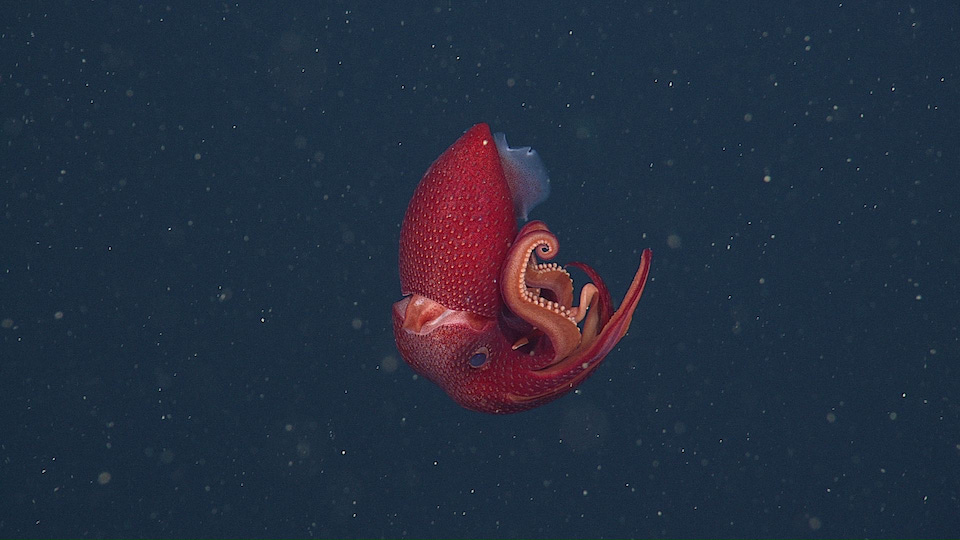Welcome to the Mini Neptunes Notes, a slightly smaller species spotlight for the quirky and the cute creatures who might not be a cetacean, but still deserve to be celebrated on Beached.
Enjoy! 🐙
If you thought the ocean’s twilight zone was full of slugs and bugs, all teeth and tentacles, the spiny and the serpentine, you’d be exactly right. But among the vampires, vipers, and goblins a thousand metres deep, there’s a rather sweet creature hiding in plain sight - the Strawberry Squid.
Small and not quite symmetrical, but a cute and vibrant berry-red, this squid is aptly named. And though the rich red pigmentation of its skin might not be enough to warrant comparison to an actual strawberry, its photophores’ (footnote: A photophore is a glandular organ that appears as luminous spots on various marine animals) likeness to strawberry seeds certainly do.
These marvellous squids measure just 5 inches (13cm) in length and can be found in the mesopelagic zone of the Eastern Pacific Ocean. Like many of its twilight zone neighbours, the strawberry squid has perfected the daily commute as it participates in the diel vertical migration. This pattern of movement sees millions of deep-sea dwellers across the ocean ascending to shallower waters come nightfall. The strawberry squid usually lurks at around 1000 metres deep during the day, rising to 300 or 400 metres below the surface when all goes dark.
This nightly ascent isn’t just for a change of scenery either. Under the cover of darkness, organisms like zooplankton, comb jellies and dragonfish can emerge from where food is scarce and enjoy a midnight snack in peace, safe from predators below.
The strawberry squid isn’t a particularly fussy eater and its diet includes a variety of shrimp, fish and even other squid. But in the thick black of the deep-sea finding food isn’t as easy as at the ocean surface, and so, like most ocean creatures, the strawberry squid has adapted in unique ways.

Aside from its vibrant colouration, the strawberry squid’s most striking feature is its mismatched eyes - so mismatched it's sometimes called the cockeyed squid. The left is significantly larger, tubular in shape to maximise light collection, and glazed with a yellow lens to see through the luminescent camouflage of its prey. This eye is permanently fixed upwards, scanning for shadows in the dimly lit waters above. The smaller right eye, in contrast, keeps watch on the darker waters below, alert for any bioluminescent signals from prey or predators. By orienting itself at a 45-degree angle, it optimises the use of both eyes.
The strawberry squid also employs a distinctive scanning technique known as ‘ratcheting’, where the mantle (the conical-shaped hat) twists relative to the rest of the head, before the head snaps around to rejoin it, all while keeping the left eye fixed towards the surface. All of this to say, don’t try and sneak up on it.
But it's not just the eyes that make this squid a sight to behold – its vibrant crimson body is dotted with tiny light-producing organs called photophores. These little bio-lights give the squid its strawberry-seed appearance and allow it to communicate, attract mates, and even lure prey. More crucially, they aid in counter-illumination – by emitting a steady blue light, the squid can blend with the downwelling sunlight, effectively erasing its silhouette when viewed from above. In the absence of red light at great depths, its crimson hue appears black anyway, helping it hide from predators like sperm whales, dolphins, tuna, swordfish, and sharks.
But, because most ocean creatures are cunning enough to keep some tricks up their sleeve, the strawberry squid will, on occasion, be spotted. Once again, it is well-prepared. When threatened it will produce ‘pseudomorphs' - dense blobs of ink that mimic the squid's shape and size. This clever decoy allows the squid to make a swift escape while predators are distracted. Interestingly, the squid often lingers within the ink cloud unless further provoked, using it as a form of concealment. Most likely because inking uses up a considerable amount of energy as it requires the release of melanin and mucus, so the strawberry squid is loath to use it.
These remarkable adaptations – from its unique eyes and bioluminescent capabilities to its inking strategy and daily vertical migration – showcase the incredible ways the strawberry squid has evolved to thrive in the challenging environment of the deep sea. With its bedazzling appearance and array of survival tricks, it truly stands out as one of the ocean's most fascinating creatures. Also, it looks like a FREAKING STRAWBERRY!!!
Here at Beached we are building a community that can put our brains and resources together to highlight and fund solutions to the problems facing the Strawberry Squid and the oceans they live in. I hope you’ll join our humble community and click subscribe for free or support our work by purchasing the paid subscription.
All Beached posts are free to read but if you can we ask you to support our work through a paid subscription. These directly support the work of Beached and allow us to engage in more conversations with experts in the field of marine conservation and spend more time researching a wider breadth of topics for the newsletters. Paid subscriptions allow us to dedicate more time and effort to creating a community and provide the space for stakeholders to come together, stay abreast of each other’s work and foster improved collaboration and coordination.
One day Beached hope to donate a large percentage of the revenue from paid subscriptions to marine conservation organisations and charities to support their work too. Working together, we can reverse the degradation of our oceans.
Amie 🐋







Evolution is so clever sometimes!
THEY ARE SO CUTE!!!!🥰